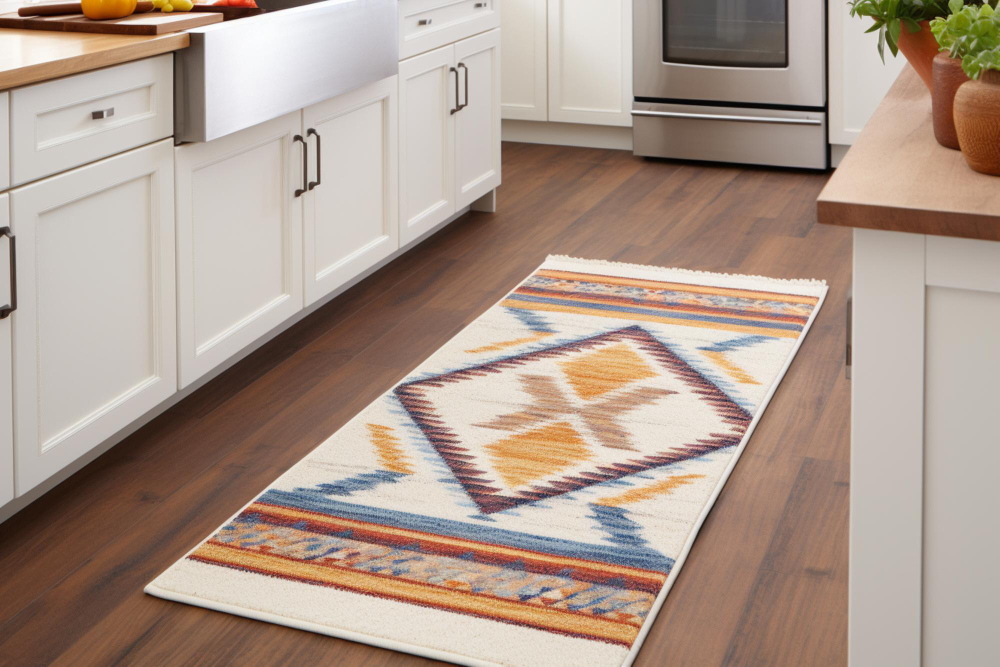The Pros and Cons of a Kitchen Rug

Adding a rug to your kitchen space can transform its look and feel. From elevating the overall design to providing practical benefits like cushioning underfoot, kitchen rugs are a versatile addition to any home. But, as with any decor decision, there’s no one-size-fits-all approach. Every rug comes with its own advantages and challenges.
If you’re on the hunt for the perfect floor accessory for your kitchen or are exploring options at a rug store in Phoenix, AZ, this guide will help you weigh the pros and cons before making your purchase.
Why Consider a Kitchen Rug?
Kitchens are often the heart of the home, bustling with activity and foot traffic. A rug can serve both functional and aesthetic purposes in this space. However, the question of whether a kitchen rug is the right choice for you depends on your specific needs and preferences. Below, we’ll break down the upsides and potential drawbacks to help you decide.
Benefits of Using a Kitchen Rug
1. Enhances Aesthetic Appeal
Adding a rug to your kitchen is one of the easiest ways to uplift its design. Whether you prefer a bold, patterned statement rug or a subtle, minimalist design, the right rug can tie the room together and reflect your style.
Rugs come in a variety of textures, colors, and designs, meaning there’s something for every taste. If you’re in Phoenix, AZ, visiting a local rug store like Organic Looms can provide an array of options to perfectly match your kitchen’s decor scheme.
2. Adds Comfort and Cushioning
Kitchens can be hard on your feet, especially when you’re standing for extended periods while cooking or cleaning. Rugs, particularly those with a plush pile or added padding, provide cushioning and reduce pressure on your feet and joints.
3. Reduces Noise Levels
Kitchens can be quite noisy, with clattering dishes, appliances whirring, and footsteps echoing on hard floors. Rugs act as a sound absorber. Placing one strategically in your kitchen can help dampen noise and create a calmer, more pleasant atmosphere.
4. Offers Protection for Your Floors
If your kitchen has hardwood or tile flooring, a rug can help prevent scratches, dents, or other wear and tear caused by frequent foot traffic or dropping heavy objects. Adding a non-slip rug pad underneath can also provide an extra layer of floor protection.
5. Improves Safety
Kitchens are prone to spills, which can make hard flooring slippery and hazardous. A quality kitchen rug, especially one with a non-slip backing, can decrease the risk of slips and falls.
Drawbacks of a Kitchen Rug
1. Cleaning and Maintenance
Kitchen rugs are magnets for spills, crumbs, and stains. From oil splatters near the stove to coffee spills in the morning rush, keeping a kitchen rug clean can take extra effort.
If you choose to add a rug to your kitchen, look for materials that are stain-resistant and easy to clean, like polypropylene, or rugs that are machine washable.
2. Need for Frequent Replacement
Because of their location, kitchen rugs can wear out faster than rugs in low-traffic areas. Constant exposure to spills, dirt, and moisture can cause discoloration and damage over time, resulting in the need for replacement more frequently than rugs in other rooms.
3. Potential for Slips Without Proper Backing
While rugs can improve safety, they can also increase the risk of tripping if they don’t have a non-slip backing. Always ensure your rug stays securely in place by opting for a rug with a sturdy grip or by using a rug pad.
4. Limited Durability in High-Traffic Areas
If your kitchen is particularly busy, even durable materials may show signs of wear quickly. Runners are especially susceptible to fraying at the edges or flattening in high-traffic zones like in front of the sink or stove.
5. Space Constraints
Not every kitchen layout accommodates a rug. Smaller kitchens might feel cramped, especially if the rug doesn’t fit seamlessly with the space or obstructs the movement of chairs or appliances.
Tips for Choosing the Perfect Kitchen Rug
Choosing the right rug involves balancing style, functionality, and ease of care. Here are a few tips to guide you through the selection process:
- Go for Durable Materials: Consider materials like polypropylene, natural fibers such as jute, or even washable synthetic rugs for easy maintenance.
- Pick the Right Size: Ensure the rug isn’t too large for your space. It should ideally sit flush under kitchen appliances or leave enough space for doorways to move freely.
- Non-Slip Backing is a Must: Safety first! Always select a rug with anti-slip features or add a non-slip pad underneath to keep it secure.
- Match Your Decor: Visit a local rug store in Phoenix, AZ, like Organic Looms, to find a piece that complements your kitchen’s design theme.
- Focus on Easy Cleaning: Since kitchens are prone to messes, opt for rugs that are machine washable or have stain-resistant properties.
Is a Kitchen Rug Right for You?
Ultimately, the decision to add a rug to your kitchen rests on your personal preferences and lifestyle. While the aesthetic and comfort benefits make them a lovely addition to many kitchens, it’s essential to consider the maintenance involved and potential drawbacks like wear and safety risks.
If you’re ready to explore a variety of stylish and functional rugs, Organic Looms in Phoenix, AZ, offers options that cater to every taste and budget. Choose from a wide selection of materials, colors, and designs that will bring your kitchen vision to life.